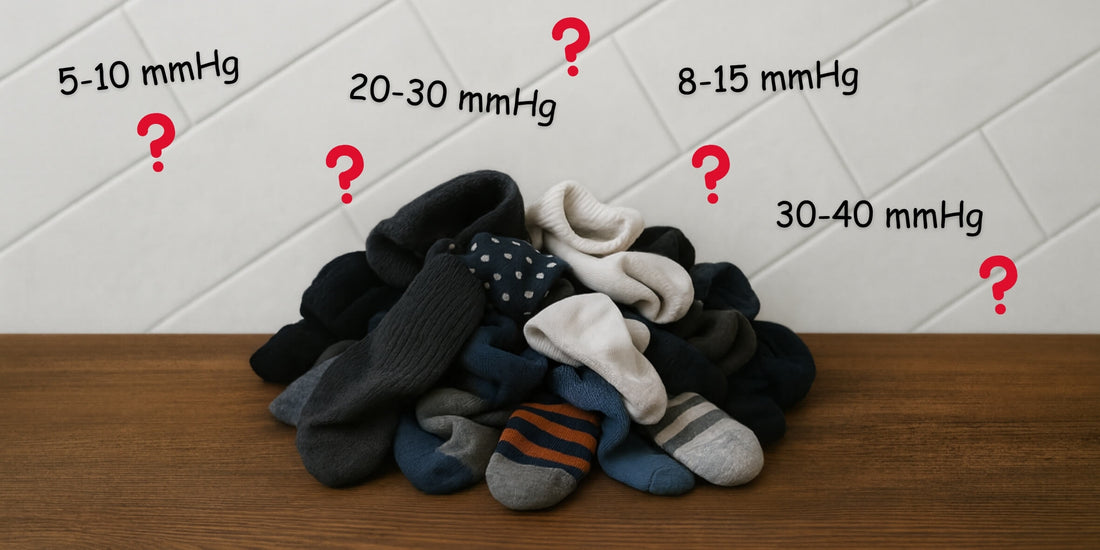
What Compression Level Is Best for Nurses? A Guide to Long-Shift Comfort
Why Choosing the Best Compression Level for Nurses Matters
You’re 8 hours into a 12-hour shift, and your legs are screaming. That achy, heavy feeling makes every step feel like your shoes are filled with cement. “Get compression socks,” they said — as if slipping on a pair would have you prancing around the hospital like a pony in the morning sun.
So here you are, determined to give it a go… only to land in a sea of options. Different brands, endless promises, and wait — compression levels? Crikey! This is turning into more effort than charting after a double.
But here's the truth: not all compression levels are the same, and choosing the right one could be the difference between dragging aching legs through your final rounds or walking out of work with light, energized legs that are ready for life outside the ward.
Don’t worry, we’ll cut through the noise. Let’s break down which compression level actually works best for nurses, why it matters, and how you can choose without all the bullsh*t.
Compression Sock Levels Explained
Let’s talk about one of the most important — and most confusing — parts of choosing compression socks: the compression level.
Firstly, if you would like to know if what features to look for when choosing good nursing socks, your can check out our blog here.
Compression socks aren’t one-size-fits-all; they come in different levels designed for different needs, from everyday wear to long-haul flights and even powerlifting. The pressure is measured in mmHg (millimeters of mercury), and the rule is simple: the higher the number, the stronger the compression.
For non-medical use, most socks range between 5 mmHg and 30 mmHg. Lower levels offer gentle support, while higher levels provide more firmness and circulatory support.
Now that you know how compression levels work, let’s dive into which level is best for nurses pulling those long shifts on their feet.
What Compression Level Do Nurses Really Need?
So what compression level is actually best for you — the hardworking nurse pulling 12+ hour shifts on your feet? That’s the golden question. At Scrubcare Footwear, we dug into it like our lives (and your legs) depended on it.
Our goal was simple: design a pair of nursing socks that not only maximizes your comfort but also keeps your legs performing through the entire shift, not just the first half. That meant testing a wide range of compression levels and how that compression was applied — which is where graduated compression comes in. Instead of squeezing your legs evenly, graduated compression applies the most pressure at the ankle and gradually decreases as it moves up the calf. This boosts circulation, reduces swelling, and keeps blood moving where it needs to go. Think of it like an escalator for your blood.
Here’s what we discovered:
-
15–20 mmHg (what most “nurse socks” use) felt good at the start of a shift, but by hour 8 to 12, legs were still heavy, swollen, and achy. It just didn’t have the grunt to support the vascular system through those final, never-ending hours.
-
20–30 mmHg told a different story. Nurses reported less swelling, lighter legs, and the ability to keep moving even in the final hours. The majority of nurses in our test preferred the 20-30 by a long shot.

After dozens of 12-hour shifts and countless samples, the verdict was clear: for nurses, 20–30 mmHg graduated compression is the sweet spot — strong enough to support circulation all day, and with the graduation that makes comfort last from start to finish.
Extra Tips for Choosing the Right Nursing Socks
Compression is only part of the equation. Sure, grabbing any pair rated 20–30 mmHg will give your legs some relief — but if the socks weren’t designed for nursing, you’ll feel the difference by the end of your shift. After all, you’re on your feet for hours at a time. Comfort, durability, and nurse-specific features matter just as much as compression.
When we designed Scrubcare Footwear, we built in the details that make sense for your reality on the floor:
-
Thick padded soles to soften every step on rock-hard hospital floors.
-
A seamless footbox so your toes stay rub-free, even after miles of walking.
-
Left and right foot design (sounds obvious, but most socks don’t do it) for better long-term comfort.
-
Ventilation zones on top of the foot and behind the calf for extra breathability during intense shifts.
Whether you choose Scrubcare or another brand, look for socks built specifically for nurses. Those are the ones that will keep up with you shift after shift.
The Best Compression Level for Nurses: Final Thoughts
At the end of the day, most nurses find 20–30 mmHg graduated compression gives them the best balance of comfort and support for long shifts. Pair that with nurse-specific features like padding, seamless toes, and breathability, and your legs will thank you. Who knows — you might even feel like that pony gallivanting through the ward after all.
👉 If you want to experience the comfort and performance of compression socks designed specifically for nursing, check out our full Scrubcare Footwear collection here.






